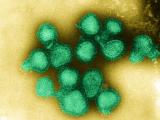Dec 17, 2010 (CIDRAP News) – With signs that the flu season is picking up momentum, the Department of Health and Human Services (HHS) today unveiled a demonstration project to raise flu vaccination rates in minority groups, backed by $10 million worth of vaccine vouchers from Walgreens.
The vouchers, which can be distributed by community groups along with local and state health departments, target 15 cities with large minority populations and can be redeemed at Walgreens stores or at the company's Take Care clinics.
HHS Secretary Kathleen Sebelius said at a press briefing today that the nation is making good progress this year in getting the vaccine into people's arms, and so far about a third of Americans have been immunized. However, she said numerous individuals are still unprotected, including many in African American and Hispanic populations, who are more likely to have chronic medical conditions that put them at high risk for flu complications.
"Private partners are stepping up to do their part," Sebelius said. "My colleagues and I are really pleased with this opportunity."
The project also includes a communications component to boost flu vaccine awareness among minority groups, with the rollout of new public service announcements to 11,000 radio stations, said Sebelius. The HHS said in a blog post today that the National Medical Association and the National Hispanic Medical Association will be working with federal officials to raise flu vaccine awareness among providers and will test several provider-based practices, such as standing orders and reminder recall systems.
Kermit Crawford, president of pharmacy services at Walgreens, called his company's donation an important initiative in the effort to reduce health disparities among underserved groups. He said Walgreens has 26,000 pharmacists who are authorized to administer flu vaccine. "There's always an opportunity to do more by playing an integral role in protecting people," he said.
Crawford said the vouchers will allow 350,000 people to be immunized.
He said the demonstration project launches next week in eight cities: Atlanta; the Bronx, NY; Chicago, Houston, Kansas City, Mo.; Newark, NJ; Oakland, Calif., and Philadelphia. The second phase of the project will target seven more sites: Fort Lauderdale, Fla.; Miami; Palm Beach, Fla., Seattle; Waco, Tex.; Washington, DC; parts of New York City including Brooklyn, Staten Island, Queens, and Harlem; and northern New Hampshire.
Dr. Howard Koh, assistant secretary for health at the HHS, said disparities in flu vaccination rates is not new and has been a factor for far too long. "We need to reach people where they live, work, pray, and play," he added. A recent snapshot of this season's flu vaccine uptake showed that immunization rates for whites was 10% higher than for blacks or Hispanics.
Koh said the demonstration project sites represent areas that have large African American or Hispanic populations and also have Walgreens stores.
"We are very eager to work closely with Walgreens and regional health administrators to make this come alive in these communities," Koh said.
Dr. Dan Jernigan, deputy director of the CDC's Influenza Division, said the timing of the demonstration project is good, because there are signs that the nation's flu season is starting to escalate. "There's a steady increase in doctor's office visits, as we'd expect for this time of year," he said.
So far there have been few hospitalizations and very few deaths. "It's a great time to be vaccinated," Jernigan said.
Weekly flu report
The CDC noted today in its weekly flu surveillance report that the number of respiratory specimens testing positive for influenza rose slightly to 11%, up from 10.8% the previous week. Four states, mostly in the southeastern part of the country, and Puerto Rico reported regional activity, while 20 states reported local activity, which was an increase of eight from the previous week.
Doctor visits for flu-like illnesses were still below the national baseline, and deaths from flu and pneumonia were below the epidemic threshold. Most of the circulating strains are still influenza A (H3N2) and influenza B.
One pediatric fatality was reported, a child from New York whose H3N2 death was reported to the CDC near the end of November.
Jernigan said the circulating flu viruses are still a good match with the strains included in the vaccine, and laboratories have not noted any increases in antiviral resistance.
Novel flu virus case
The CDC said it received one report of a novel influenza A infection, a patient from Minnesota who was hospitalized in November for a swine-origin influenza virus infection. The patient had contact with pigs the week before becoming sick.
In a separate statement, the CDC said there is no evidence so far of person-to-person spread or community transmission of the novel virus.
The infections are rare, and they typically occur in people who have contact with livestock. Since 2005 the CDC has received 19 reports of swine-origin flu infections, of which six—including the Minnesota case—were H3N2.
See also:
Dec 17 HHS blog post
Dec 17 Walgreens press release
Dec 17 CDC flu surveillance update
Dec 17 CDC swine flu case statement



















